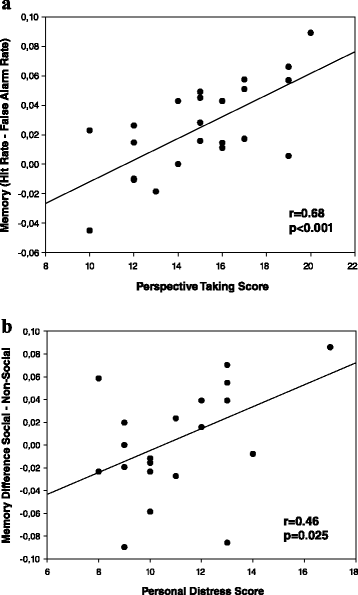The relationship between trait empathy and memory formation for social vs. non-social information
- PMID: 25685356
- PMCID: PMC4322958
- DOI: 10.1186/s40359-015-0058-3
The relationship between trait empathy and memory formation for social vs. non-social information
Abstract
Background: To navigate successfully through their complex social environment, humans need both empathic and mnemonic skills. Little is known on how these two types of psychological abilities relate to each other in humans. Although initial clinical findings suggest a positive association, systematic investigations in healthy subject samples have not yet been performed. Differentiating cognitive and affective aspects of empathy, we assumed that cognitive empathy would be positively associated with general memory performance, while affective empathy, due to enhanced other-related emotional reactions, would be related to a relative memory advantage for information of social as compared to non-social relevance.
Methods: We investigated in young healthy participants the relationship between dispositional cognitive and affective empathy, as measured by Davis' Interpersonal Reactivity Index (Journal of Personality and Social Psychology, 44, 113-126, 1983), and memory formation for stimuli (numbers presented in a lottery choice task) that could be encoded in either a social (other-related) or a non-social (self-related) way within the task.
Results: Cognitive empathy, specifically perspective taking, correlated with overall memory performance (regardless of encoding condition), while affective empathy, specifically empathic personal distress, predicted differential memory for socially vs. non-socially encoded information.
Conclusion: Both cognitive and affective empathy are associated with memory formation, but in different ways, depending on the social nature of the memory content. These results open new and so far widely neglected avenues of psychological research on the relationship between social and cognitive skills.
Keywords: Affective empathy; Cognitive empathy; Personal distress; Perspective taking; Social memory.
Figures


Similar articles
-
Age-related differences in affective and cognitive empathy: self-report and performance-based evidence.Neuropsychol Dev Cogn B Aging Neuropsychol Cogn. 2018 Sep;25(5):655-672. doi: 10.1080/13825585.2017.1360835. Epub 2017 Aug 4. Neuropsychol Dev Cogn B Aging Neuropsychol Cogn. 2018. PMID: 28774223
-
Self-reported empathic abilities in schizophrenia.Schizophr Res. 2007 May;92(1-3):85-9. doi: 10.1016/j.schres.2007.01.024. Epub 2007 Mar 9. Schizophr Res. 2007. PMID: 17350225
-
Cognitive and affective empathy in younger and older individuals.Aging Ment Health. 2014 Sep;18(7):929-35. doi: 10.1080/13607863.2014.899973. Epub 2014 May 14. Aging Ment Health. 2014. PMID: 24827596
-
Neuronal Correlates of Empathy: A Systematic Review of Event-Related Potentials Studies in Perceptual Tasks.Brain Sci. 2024 May 16;14(5):504. doi: 10.3390/brainsci14050504. Brain Sci. 2024. PMID: 38790482 Free PMC article. Review.
-
A meta-analytic review of the relations between anxiety and empathy.J Anxiety Disord. 2024 Jan;101:102795. doi: 10.1016/j.janxdis.2023.102795. Epub 2023 Nov 19. J Anxiety Disord. 2024. PMID: 38039916 Review.
Cited by
-
Exploring the role of digital media dependency on the relationship between personal involvement and flashbulb memory during the pandemic: Empirical evidence from Mainland China.Front Psychol. 2022 Nov 11;13:985287. doi: 10.3389/fpsyg.2022.985287. eCollection 2022. Front Psychol. 2022. PMID: 36438306 Free PMC article.
-
Empathic responding and hippocampal volume in young children.Dev Psychol. 2019 Sep;55(9):1908-1920. doi: 10.1037/dev0000684. Dev Psychol. 2019. PMID: 31464494 Free PMC article.
-
Empathy, memory, and aging during the COVID-19 pandemic.Curr Res Ecol Soc Psychol. 2023;4:100105. doi: 10.1016/j.cresp.2023.100105. Epub 2023 Apr 17. Curr Res Ecol Soc Psychol. 2023. PMID: 37091210 Free PMC article.
-
Emerging Directions in Emotional Episodic Memory.Front Psychol. 2017 Dec 4;8:1867. doi: 10.3389/fpsyg.2017.01867. eCollection 2017. Front Psychol. 2017. PMID: 29255432 Free PMC article. Review.
-
When Does Oxytocin Affect Human Memory Encoding? The Role of Social Context and Individual Attachment Style.Front Hum Neurosci. 2018 Sep 20;12:349. doi: 10.3389/fnhum.2018.00349. eCollection 2018. Front Hum Neurosci. 2018. PMID: 30294265 Free PMC article.
References
-
- Baron-Cohen S, Wheelwright S, Hill J, Raste Y, Plomb I. The ‘Reading the Mind in the Eyes’ test revised version: a study with normal adults, and adults with Asperger syndrome or high-functioning autism. Journal of Child Psychology and Psychiatry. 2001;42:241–252. doi: 10.1111/1469-7610.00715. - DOI - PubMed
-
- Batson CD, O’Quin K, Fultz J, Vanderplas M, Isen AM. Influence of self-reported distress and empathy on egoistic vs. altruistic motivations to help. Journal of Personality and Social Psychology. 1983;45:706–718. doi: 10.1037/0022-3514.45.3.706. - DOI
LinkOut - more resources
Full Text Sources
Other Literature Sources

